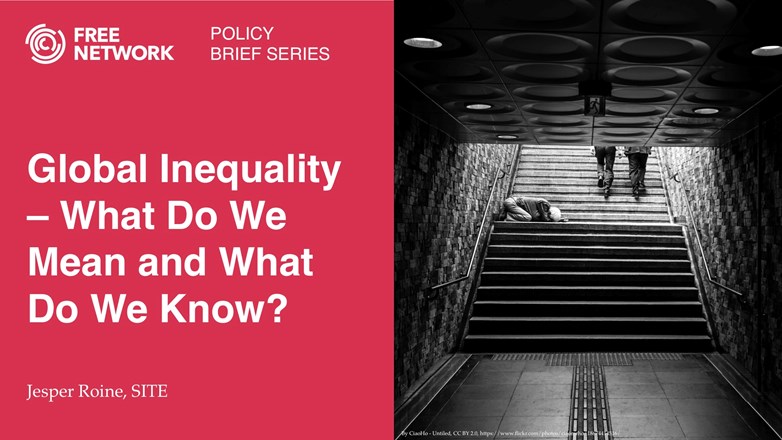Global Inequality – What Do We Mean and What Do We Know?
Concerns about economic inequality have become central in today's policy debate. This brief summarizes what is known about the development of inequality globally, emphasizing the difference between the developments within countries and between countries. In the former sense, inequality has risen in most countries in the world since the 1980s, but in the latter sense inequality has (most probably) dropped. To insure future progress in terms of continued decreasing global inequality, fighting increasing inequality within countries is likely to be central.
In recent years, the distribution of income and wealth has emerged as one of the most widely discussed issues in societies everywhere. US President Barack Obama has called rising income inequality the "defining challenge of our time", the topic has been on the agenda at meetings of the World Economic Forum in Davos, and studies by the IMF and the OECD (e.g., OECD, 2014, and IMF, 2014) have associated income inequality with lower economic growth. Thomas Piketty's best selling book "Capital in the Twenty-First Century" (2014) has placed the topic center-stage well outside academic and expert circles. At the same time, some have argued that all the talk about increasing inequality is in fact wrong and that it misses what they perceive as the more important story, namely, the decreasing global inequality. So, which is it, and what conclusions can be drawn?
Different ways of viewing the facts
When people talk about global income inequality there are a number of things that could be referred to. First, one might think of the inequality within countries across the world. From this perspective, the question in need of an answer would be: "How has inequality within individual countries changed globally in recent decades?" The short answer is that it has increased in most places. This is certainly the case in most of the developed world since the 1980s, while in emerging markets and developing countries (EMDCs) there are greater differences across time and regions. Looking at disposable incomes at the household level (the most commonly used measure in international comparisons) most countries in Asia and Eastern Europe have seen marked increases of inequality, while the trend seems to have been the opposite in Latin America and in large parts of Africa. In level terms, the development has been one of convergence since, on average, the countries in Eastern Europe and Asia started at much lower levels than those in Latin America and Africa. The development has resulted in that inequality levels are today on average at similar levels, with a Gini coefficient of between 0.4 and 0.45, in Africa, Asia and Latin America (see figure 1 below and IMF, 2015) The same is true for the average across OECD countries where inequality has increased the most in percentage terms in countries staring at low levels, with the US being an exception in that inequality has increased even though the level has always been at the higher end among developed economies (e.g., OECD, 2015). The European average is today around 0.3 while the household disposable income Gini in the US is just below 0.4.
Figure 1. Change in the net Gini Index, 1990-2012

Source: IMF, 2015.
Looking at other income inequality measures, such as top income shares, the picture is similar: inequality has increased in most countries for which we have data since the 1980s. While it is important to recognize that top income shares are a very different measure of inequality, it has been shown that there is a close relationship between top income shares and the Gini coefficient in terms of capturing both level differences across countries and trends in the development (e.g., Leigh, 2007 and Morelli, Smeeding and Thompson, 2015). This together with one of the main strengths of the top income measure, namely, the length of the time series, allows us to put the recent developments in a historical perspective.
Figure 2 shows the income share of the top decile group for a number of mainly developed countries over the 20th century, illustrating the surprisingly common trends over the past 100 years (but also important level differences). On average, top shares (driven mainly by what happened in the top 1 percent) dropped from the beginning of the century until about 1980 after which it has risen in a fanning-out fashion. The point of the figure is clearly not to illustrate any individual country but rather to illustrate the overall long run trend. For details of the historical development of income as well as wealth distribution, see Roine and Waldenström (2015).
Figure 2. Top 10 percent income share over the 20th century

Source: World top income database (WTID).
While the overall picture of rising inequality in most countries over the past decades is pretty clear, the development between countries is less so. There are two main reasons for this. First, it depends on what is considered the unit of observation and how these units are weighted. Second, it depends on what one assumes about the vast gaps in data availability, in particular in EMDCs (see e.g., Lakner and Milanovic, 2013, for more details).
As explained by for example Milanovic (2012) there are essentially three different ways in which one might think about a global distribution of income: 1) Treat every country as one observation and use a country's GDP per capita as the measure of income; 2) do the same as in 1) but give different weight to each country according to its population; 3) Treat individuals (or households) as the unit of observation regardless of where people live. In all three cases it is possible to line up all observations from the poorest to richest (and, hence, also to calculate a Gini coefficient). In the first way of looking at the world, we treat everyone in each country as being represented by the country's average income and we also give the same weight to Luxemburg and India. In the second case, we recognize that more people live in India and weight it accordingly but we still, by construction, force everyone in each country to have the country average, thus ignoring within country inequality. Only in the last approach do we actually take into account both relative population size and differences in development within countries. This clearly seems the most satisfactory way to look at what has happened, but it is also the most demanding in terms of data.
In terms of the first two approaches, inequality in the world has fallen in the past decades. This is especially clear when weighting countries by population size. Rapid growth in China and India has caused average incomes in the world's most populous and initially poor countries to increase faster than the global average, implying a reduction in global inequality. Some may think that this is not surprising and only to be expected since these countries start at such low levels, but in fact this development marks the reversal of a 200-year trend toward increasing global inequality. Even "catch-up growth" is certainly not to be taken for granted.
Now the real question is this: What has happened to the global income distribution if we take into account the recent increasing inequality within many countries, including China and India? The answer turns out to complicated and uncertain (see Lakner and Milanovic, 2013 for details) but in the end most of the evidence points to decreasing global inequality in this sense too. As François Bourguignon puts it in a recent article in the Foreign Affairs: "...the increase in national inequality has been too small to cancel out the decline in inequality among countries" (Bourguignon, 2016, p. 14).
To understand both of these counteracting forces it is illustrative to look at real income growth across the global income distribution. Figure 3 below is taken from a presentation by Branko Milanovic, organized by SITE in 2014 (and available online here). It shows the real income growth for different percentile groups in the global distribution over the period 1988-2008. Moving from left to right the figure shows positive but modest growth for the very poorest individuals in the world, and a much higher growth for the groups just above, with rates increasing toward the middle of the global distribution. In the range of about 5 dollars/day (in PPP adjusted terms) growth has been the highest. By developed-country standards these people are still very poor, but globally they are truly the "middle class" in the sense that they make up the middle of the global income distribution. Moving further right we see a sharp drop in real income growth at a level around the 80th percentile. This part of the distribution is mainly populated by the lower middle classes of the developed world, and here income growth has been essentially zero over the past decades. Moving further right we again see a sharp increase in real income growth illustrating the large gains going to individuals in the top of the global income distribution.
Figure 3 summarizes much of what has happened: the left part showing the rapid growth of income among most of the world's relatively poor, while the right shows the increasing inequality in the developed world, with the top of the distribution gaining the most.
Figure 3. Real income growth at various percentiles of global income distribution, 1988-2008 (in 2005 PPPs).

Source: Lakner and Milanovic (2013).
Why this matters and what should be done?
The forces that explain what has happened are of course complex and differ over time and across countries but one thing seems clear, the growth of real incomes in developing countries as well as the relative decline of incomes in the lower end of the income distribution in developed countries have at least in parts been shaped by the same intertwined processes of globalization and technological development. Overall, these processes are powerful positive developments, but at the same time it is easy to see how those who perceive themselves as losers in these developments may try to resist them using their political voice. It is important to remember that globalization is the result of a combination of technology and political decisions, and consequently not an inevitable process. After all, the globalization backlash in the period 1914-1945 did not happen because the technological feasibility of the process suddenly disappeared.
The appropriate government responses are of course also likely to be different across countries, but here there are also some common factors that stand out. In the developing world, the most challenging aspects will have to do with maintaining state capacity and the ability to tax increasingly mobile tax bases. In many developing countries taxation will also be key, but here the challenge is more about creating a capable and accountable state in the first place. As succinctly and, I think, correctly put by Nancy Birdsall in a review of Thomas Piketty's "Capital in the Twenty-First Century": "(I)n the developing world, the challenge is not, at least not yet, the one Piketty outlines — that an inherent tendency of capitalism is to generate dangerous inequality that if left unchecked will undermine the democratic social state itself. The challenge is the other way around: to build a capable state in the first place, on the foundation of effective institutions that are democratically accountable to their citizens."
References
- Atkinson, Anthony B. 2015. "Inequality – What can be done?" Harvard University Press.
- Birdsall, Nancy. 2014. "Thomas Piketty's Capital and the developing world"
- Ethics & International Affairs / Volume 28 / Issue 04 / Winter 2014, pp 523-538.
- Bourguignon, François, and Christian Morrison. 2002. "Inequality among World Citizens: 1820-1992", The American Economic Review, Vol. 92, No. 4. (Sep., 2002), pp. 727-744.
- Bourguignon, François. 2016. "Inequality and Globalization. How the rich get richer as the poor catch up", Foreign Affairs, Volume 95, Number 1, pp. 11-16
- Lakner, Christoph, and Branko Milanovic. 2013. "Global Income Distribution: From the Fall of the Berlin Wall to the Great Recession." WB Policy Research Working Paper 6719, World Bank, Washington.
- Leigh, Andrew. 2007. "How closely do top income shares track other measures of inequality?", The Economic Journal, 117 (November), 589–603.
- OECD (2015), "Growth and income inequality: trends and policy implications", OECD Economics Department Policy Notes, No. 26 April 2015.
- OECD. 2011. Divided We Stand: Why Inequality Keeps Rising. Paris: OECD Publishing.
- OECD. 2012. "Reducing Income Inequality While Boosting Economic Growth: Can It Be Done?" In Economic Policy Reforms: Going for Growth. Paris: OECD Publishing.
- Ostry, Jonathan David, Andrew Berg, and Charalambos G. Tsangarides. 2014. "Redistribution, Inequality, and Growth", IMF SDN, February 17, 2014
- Milanovic, B. 2013. "Global Income Inequality by the Numbers: in History and Now." Global Policy 4 (2): 198–208.
- Morelli, Salvatore, Smeeding, Timothy, and Jeffrey Thompson. 2015. "Post-1970 Trends in Within-Country Inequality and Poverty: Rich and Middle Income Countries", Chapter in Atkinson, A.B., Bourguignon, F. (Eds.), Handbook of Income Distribution, vol. 2A, North-Holland, Amsterdam.
- Piketty, Thomas. 2014. "Capital in the Twenty-first Century". Cambridge, Massachusetts: Harvard University Press.
- Pritchett, Lant. "Divergence, Big Time." Journal of Economic Perspectives, Summer 1997, 11(3), pp. 3-17.
- Roine, Jesper, and Daniel Waldenström. 2015. "Long-Run Trends in the Distribution of Income and Wealth", Chapter in Atkinson, A.B., Bourguignon, F. (Eds.), Handbook of Income Distribution, vol. 2A, North-Holland, Amsterdam.
This policy brief is published on Forum for Research on Eastern Europe and Emerging Economies (FREE Network) Policy brief series. FREE Network is a joint initiative by seven think tanks - SITE (Stockholm), BEROC (Minsk), BICEPS (Riga), CEFIR (Moscow), CenEA (Szczecin), ISET (Tbilisi) and KSE (Kiev). Together, these research institutes form an extensive network of leading academic experts on economic issues in Central and Eastern Europe and the former Soviet Union. For more information please visit the website of FREE Network here.
Download the Policy brief "Global Inequality – What Do We Mean and What Do We Know?" here or read it on SITE's Slideshare channel below.




